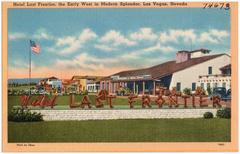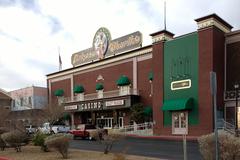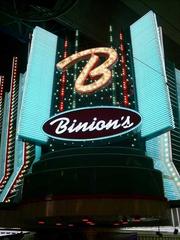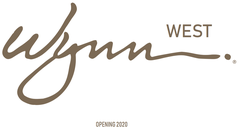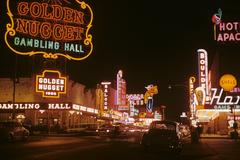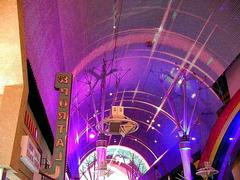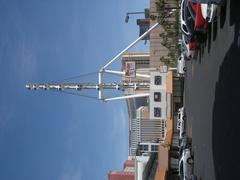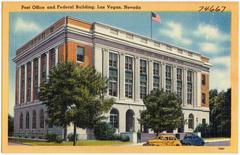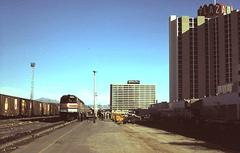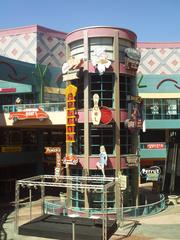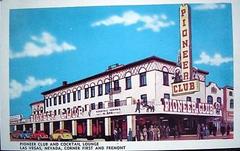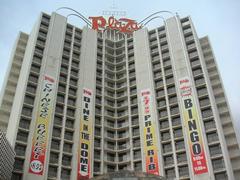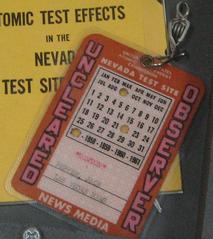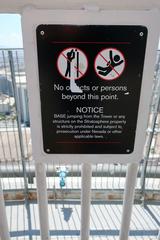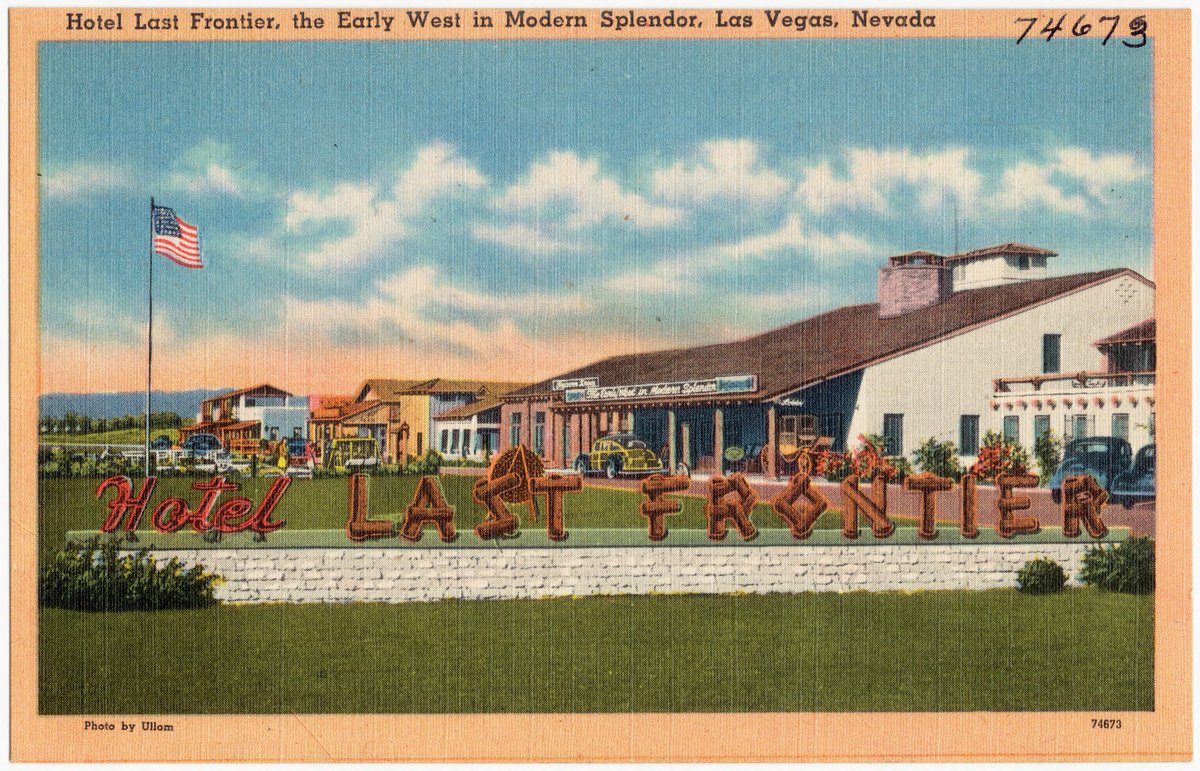
New Frontier Hotel and Casino Las Vegas: Visiting Hours, Tickets, and Attractions Guide
Date: 14/06/2025
Introduction: The Legacy of the New Frontier Hotel and Casino
The New Frontier Hotel and Casino occupies a celebrated place in Las Vegas history, standing as the Strip’s second-ever resort and a forerunner in themed entertainment. Since its debut in 1942 as the Hotel Last Frontier, it contributed significantly to the city’s transformation into the “Entertainment Capital of the World.” Though the hotel was demolished in 2007 and its site remains vacant, the New Frontier’s cultural and historical footprint endures through preserved artifacts, ongoing legends, and the continued operation of the Little Church of the West (Vintage Las Vegas; UNLV Special Collections). This guide details the New Frontier’s evolution, visitor resources, and how to experience its legacy today.
Historical Overview
Founding and Early Years (1942–1951)
The New Frontier began life as the Hotel Last Frontier, opening on October 30, 1942, as the second resort on what would become the Las Vegas Strip. Its founders, R.E. Griffith and William J. Moore, transformed the Pair O’ Dice Nite Club into a full-scale resort featuring an immersive Old West theme. Key attractions included the Last Frontier Village—an authentic Western streetscape reconstructed with historic buildings from across Nevada—and the Little Church of the West wedding chapel, now the Strip’s oldest operating structure (Vintage Las Vegas; UNLV Special Collections).
Thematic and Ownership Shifts (1951–1964)
After changing hands in 1951, the property underwent significant renovations and in 1955 rebranded as the Hotel New Frontier. The new design embraced a futuristic, space-age aesthetic, reflecting 1950s optimism and America’s fascination with space exploration (Las Vegas NV Museum). The venue became an entertainment hotspot, hosting major acts such as Elvis Presley’s Las Vegas debut in 1956 and Ronald Reagan in 1954 (Vintage Las Vegas).
Expansion and the Howard Hughes Era (1964–1988)
Acquired by the Banker’s Life Insurance Company in 1964, the resort was rebuilt into a modern, larger facility. Howard Hughes purchased the New Frontier in 1967, ushering in a period of modernization and increased stature, including the installation of the iconic and ever-changing Frontier sign (UNLV Special Collections).
Labor Strife and Decline (1988–1998)
The Elardi family’s ownership from 1988 saw operational cutbacks and the onset of a historic labor dispute. The Culinary Workers Union Local 226’s strike over poor working conditions and wages lasted more than six years, making it the longest in U.S. history (UNLV Special Collections). This era marked a decline in the hotel’s reputation and profitability.
Final Years and Demolition (1998–2007)
Phil Ruffin acquired the property in 1998, renaming it the New Frontier and making efforts to revitalize the hotel, though it struggled against contemporary megaresorts. In 2007, the New Frontier was sold to the Elad Group, closed on July 16, and demolished in a dramatic implosion on November 13, 2007, ending a 65-year chapter in Vegas history (Vintage Las Vegas; Los Angeles Times).
Visiting the New Frontier Today
Can You Visit the New Frontier Hotel?
No, the New Frontier Hotel and Casino was demolished in 2007. The former site, located on the Las Vegas Strip between Fashion Show Mall and Resorts World Las Vegas, remains vacant and is fenced off with no public access or on-site attractions (Shelter Realty; Las Vegas Review-Journal).
Current Status, Accessibility, and Tickets
- Site Accessibility: The property is closed and inaccessible to the public. There are no visiting hours or tickets, and trespassing is prohibited. Visitors can only view the vacant lot from public sidewalks along Las Vegas Boulevard.
- Development Updates: Wynn Resorts currently owns the land, but no new development plans have been announced as of mid-2025 (Las Vegas Review-Journal).
Exploring the Legacy: Museums and Nearby Attractions
While the original New Frontier is no longer standing, its history lives on through several notable sites:
- Neon Museum: Visit the Neon Museum to see original New Frontier signage, including the iconic “longhorn” sign. The museum offers guided tours (typically 10 a.m. to 8 p.m.), with tickets ranging from $20 to $30. Advance booking is recommended, especially during peak seasons. The museum is wheelchair accessible and located near other attractions like Fremont Street and the Mob Museum.
- Little Church of the West: The only remaining building from the original Last Frontier complex, this historic chapel is open to visitors at 4617 Las Vegas Boulevard South. It continues to host weddings and is listed on the National Register of Historic Places.
- Other Nearby Attractions: The Fashion Show Mall, Resorts World Las Vegas, and various historical markers make the area worth exploring, even in the absence of the New Frontier itself.
Cultural and Historical Significance
The New Frontier was a trailblazer in themed resort design and entertainment, from its authentic Old West beginnings to its brief futuristic rebranding. It played host to cultural icons like Elvis Presley and Judy Garland, and it was the site of the longest labor strike in U.S. casino history, reflecting broader social dynamics within Las Vegas (UNLV Special Collections; Las Vegas NV Museum). Artifacts preserved in the Neon Museum and UNLV Special Collections solidify its status as a formative influence in the city’s development.
New Frontier Hotel and Casino Site: Timeline and Urban Impact
- 1942: Opened as Hotel Last Frontier.
- 1955: Rebranded as Hotel New Frontier, embracing a space-age theme.
- 1967: Purchased by Howard Hughes, modernized and expanded.
- 1991–1998: Site of the longest casino workers’ strike in U.S. history.
- 2007: Closed and imploded for future redevelopment. Site remains vacant as of 2025 (Shelter Realty).
Despite its prime location, the site’s long-term vacancy is unusual in Las Vegas, where development is typically rapid and relentless. Unrealized projects have included ambitious resort concepts, but none have come to fruition, underscoring the complexities of large-scale investment and changing market conditions (Las Vegas Review-Journal).
Visitor Tips and Recommendations
- No On-Site Access: The original New Frontier site is closed to the public. Do not attempt to enter the property.
- For History Buffs: Visit the Neon Museum for preserved signage and learn about Las Vegas’s early resort history.
- Weddings and Photos: The Little Church of the West remains operational for ceremonies and historical tours.
- Photography: The vacant lot can be photographed from public sidewalks, but no drone use or trespassing is permitted.
- Stay Updated: Follow Wynn Resorts and local news for any future development announcements.
Frequently Asked Questions (FAQ)
Q: Can I visit or tour the New Frontier Hotel and Casino today?
A: No. The hotel was demolished in 2007. The site is fenced off and inaccessible, but you can visit the Neon Museum to see original signage and artifacts.
Q: What historical attractions are near the New Frontier site?
A: The Neon Museum, Mob Museum, Fremont Street Experience, and the Little Church of the West are all nearby and recommended for historical exploration.
Q: Are there any tickets or tours available for the New Frontier site?
A: No tickets or tours are available for the vacant site; however, the Neon Museum offers tours that feature New Frontier memorabilia.
Q: What are the Neon Museum’s visiting hours and accessibility info?
A: The museum generally operates from 10 a.m. to 8 p.m., is wheelchair accessible, and offers guided tours. Check the official website for current details.
Q: Are there plans for new development on the site?
A: As of June 2025, no official plans have been announced by Wynn Resorts.
Conclusion: Remembering the New Frontier
Although the New Frontier Hotel and Casino no longer stands, its spirit is alive in Las Vegas’s culture, the Neon Museum’s dazzling signs, and the stories shared by generations of visitors and performers. Its history—marked by innovation, entertainment milestones, and social change—remains integral to the city’s identity.
For more details on Las Vegas history and up-to-date visitor resources, download the Audiala app and explore our related articles on local landmarks and museums. Stay connected for news on future developments and deeper dives into the city’s past.
References
- Vintage Las Vegas: New Frontier Hotel History
- UNLV Special Collections: New Frontier Hotel and Casino Collection
- Las Vegas NV Museum: New Frontier Hotel and Casino
- Los Angeles Times: The Final Years and Demolition of the New Frontier
- Shelter Realty: Current Status of the New Frontier Site
- Neon Museum: Frontier Collection and Exhibits
- Las Vegas Review-Journal: New Frontier Site Redevelopment
